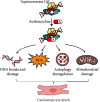Genetic Susceptibility and Mechanisms Underlying the Pathogenesis of Anthracycline-Associated Cardiotoxicity
- PMID: 35965684
- PMCID: PMC9365594
- DOI: 10.1155/2022/5818612
Genetic Susceptibility and Mechanisms Underlying the Pathogenesis of Anthracycline-Associated Cardiotoxicity
Abstract
Anthracyclines are chemotherapeutic agents widely used to treat a variety of cancers, and these drugs have revolutionized our management of cancer patients. The dose-dependent cardiotoxicity of anthracyclines, however, remains one of the leading causes of chemotherapy treatment-associated mortality in cancer survivors. Patient threshold doses leading to anthracycline-induced cardiotoxicity (AIC) are highly variable among affected patients. This variability is largely ascribed to genetic variants in individuals' genomes. Here, we briefly discuss the prevailing mechanisms underlying the pathogenesis of AIC, and then, we review the genetic variants, mostly identified through human genetic approaches and identified in cancer survivors. The identification of all genetic susceptibilities and elucidation of underlying mechanisms of AIC can help improve upfront risk prediction assessment for potentially severe cardiotoxicity disease and provide valuable insights into the understanding of AIC pathophysiology, which can be further leveraged to develop targeted pharmacogenetic therapies for those at high risk.
Copyright © 2022 Yonghe Ding et al.
Conflict of interest statement
The authors declare that there are no conflicts of interest regarding the publication of this article.
Figures


Similar articles
-
Exome array analysis identifies ETFB as a novel susceptibility gene for anthracycline-induced cardiotoxicity in cancer patients.Breast Cancer Res Treat. 2018 Jan;167(1):249-256. doi: 10.1007/s10549-017-4497-9. Epub 2017 Sep 14. Breast Cancer Res Treat. 2018. PMID: 28913729
-
Association between genetic variants of transmembrane transporters and susceptibility to anthracycline-induced cardiotoxicity: Current understanding and existing evidence.Clin Genet. 2024 Feb;105(2):115-129. doi: 10.1111/cge.14452. Epub 2023 Nov 14. Clin Genet. 2024. PMID: 37961936 Review.
-
Current views on anthracycline cardiotoxicity.Heart Fail Rev. 2016 Sep;21(5):621-34. doi: 10.1007/s10741-016-9564-5. Heart Fail Rev. 2016. PMID: 27230651 Review.
-
The genetic underpinnings of anthracycline-induced cardiomyopathy predisposition.Clin Genet. 2021 Aug;100(2):132-143. doi: 10.1111/cge.13968. Epub 2021 May 2. Clin Genet. 2021. PMID: 33871046 Free PMC article. Review.
-
Use of hiPSC to explicate genomic predisposition to anthracycline-induced cardiotoxicity.Pharmacogenomics. 2021 Jan;22(1):41-54. doi: 10.2217/pgs-2020-0104. Epub 2021 Jan 15. Pharmacogenomics. 2021. PMID: 33448871 Free PMC article. Review.
Cited by
-
Breast Cancer and Therapy-Related Cardiovascular Toxicity.J Breast Cancer. 2024 Jun;27(3):147-162. doi: 10.4048/jbc.2024.0085. Epub 2024 Apr 29. J Breast Cancer. 2024. PMID: 38769686 Free PMC article. Review.
-
Cardioprotective strategies in the management of chemotherapy-induced cardiotoxicity: current approaches and future directions.Ann Med Surg (Lond). 2024 Oct 16;86(12):7212-7220. doi: 10.1097/MS9.0000000000002668. eCollection 2024 Dec. Ann Med Surg (Lond). 2024. PMID: 39649884 Free PMC article. Review.
-
Revolutionising Cardio-Oncology Care with Precision Genomics.Int J Mol Sci. 2025 Feb 26;26(5):2052. doi: 10.3390/ijms26052052. Int J Mol Sci. 2025. PMID: 40076674 Free PMC article. Review.
-
Variants in structural cardiac genes in patients with cancer therapy-related cardiac dysfunction after anthracycline chemotherapy: a case control study.Cardiooncology. 2024 Apr 30;10(1):26. doi: 10.1186/s40959-024-00231-3. Cardiooncology. 2024. PMID: 38689299 Free PMC article.
-
Natural Products for Preventing and Managing Anthracycline-Induced Cardiotoxicity: A Comprehensive Review.Cells. 2024 Jul 6;13(13):1151. doi: 10.3390/cells13131151. Cells. 2024. PMID: 38995002 Free PMC article. Review.
References
Publication types
MeSH terms
Substances
Grants and funding
LinkOut - more resources
Full Text Sources
Medical

